The first time my team completed Destiny‘s Vault of Glass raid, it took us more than 10 hours. The second time, it took us 90 minutes.
The time difference between our first and second attempts reveals something crucial about what makes the Vault of Glass special. Its difficulty lies not in how it demands dexterity, skill, or careful shooting, though those things certainly matter. Rather, the Vault of Glass is challenging because it’s a mystery. It never tells you what to do, and can only be mastered through repeated trial and error. Your team learns and communicates, gradually coming up with successful strategies. Once you’ve learned what to do and how to do it together, it all becomes fairly easy.
The Vault of Glass is what’s known in MMO circles as a “raid”, a standalone dungeon designed for a group of high-level Destiny players to tackle as a team. For the first week that Destiny was on store shelves, the Vault wasn’t even available — it was added to the game as free downloadable content a week after everyone started playing.
The raid’s requirements are steep: All players are suggested to be at least level 26 , which means navigating the game’s time-intensive post-level cap existence. There’s no automatic matchmaking, meaning that each player will have to coordinate with a team of six friends, all of whom need microphones for voice chat. It took me the better part of two weeks to get to where I could play the first part of the raid for my review of the game, and it wasn’t until another couple of weeks later that I finally completed it.
The raid is a terrific piece of game design on its own, and becomes all the more interesting when placed against the game it accompanies. Where most of Destiny is repetitive and mechanical, the Vault of Glass is ever-changing and mysterious. Where Destiny missions all boil down to the same objective, copy-pasted over different environments, the Vault of Glass forces players to constantly adapt and learn new strategies. The Vault of Glass is an 8-course gourmet dessert following Destiny‘s bottomless bucket of fried chicken. The contrast is welcome, if jarring.
The Vault of Glass can be broken down into five separate areas, each with its own rules, challenges, and secrets:
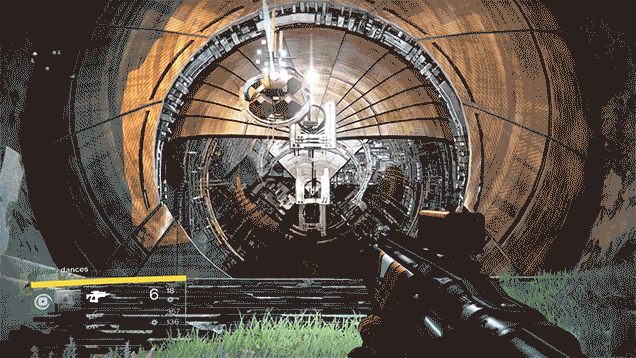
There’s the front door, which can only be opened if the team coordinates to occupy three pressure plates spread around a cliffside, all while fighting off an onslaught of difficult high-level enemies.
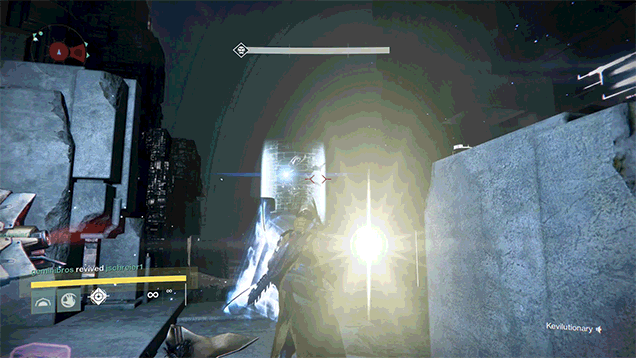
There’s the Templar battle, a five-stage boss fight that eventually has players calling out glowing “oracles” that can mark the whole team for instant death, all while one player picks up a shield relic, charges it, and uses it to fire a blast that temporarily brings down the boss’s shield so the rest of the team can launch a coordinated attack.
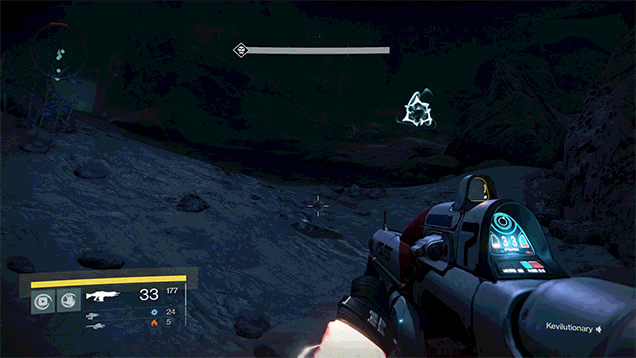
There’s The Gorgons’ Labyrinth, an area that (hilariously) introduces stealth to Destiny, forcing players to carefully make their way through a series of caves guarded by nigh-unkillable beasts that almost immediately wipe out your team if they spot you.
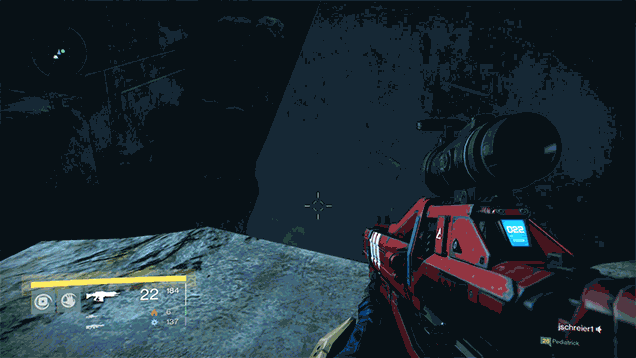
There’s a massive jumping puzzle featuring hundred-foot drops and vanishing platforms.
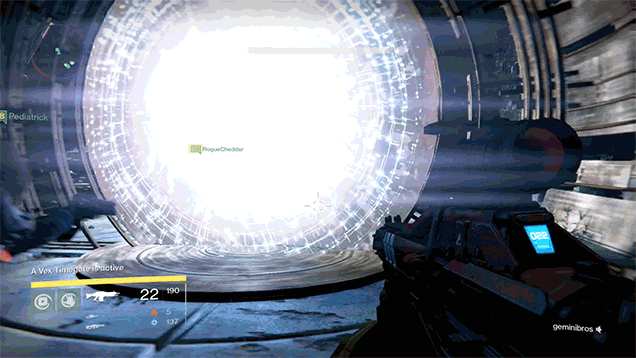
And there’s the final encounter in the Vault of Glass itself, during which you must leap through time-gates into the future and the past before taking on Atheon, a huge Decepticon robot with a gun the size of a rhinoceros who periodically teleports half of your team forward or backward in time, and whose defeat necessitates the use of a pair of relic shields, the defeat of dozens of deadly oracles, and the coordinated opening and shutting of two time-gates in a strategy so elaborate that it’d require another 500 words to document.
Pause and consider all that. If you’ve played Destiny but haven’t played the raid, the above list must sound like a completely different game to you. That’s because in a lot of ways, it is.
“The raid really is about a couple of things at the core,” Bungie’s Luke Smith told me over the phone last week. “It’s about a sense of discovery, whether it’s discovering a new environment or discovering how to tackle the problems that you’re about to encounter with your teammates. And when you think about what you want to explain, if you want the player on a journey of discovery, well, we didn’t want to explain much to them at all. Part of the fun, in fact most of the fun, is figuring it out on your own.”
“Part of the fun, in fact most of the fun, is figuring it out on your own.”
Smith, a games-journalist-turned-game-developer who, as it turns out, worked a stint for Kotaku years before I had even heard of the site, was the lead designer on the Vault of Glass. I’d reached out to him late last week to try to get a better sense of how Bungie made this weird thing, and what it might tell us about the future of Destiny. It was a cool conversation; I’ve posted a transcript of our full Q&A over at our TMI blog.
Smith led a team of four designers who worked separately from the rest of Bungie’s core Destiny group. “We worked in a pretty isolated and cool way where we were able to explore a bunch of ideas,” Smith said. “We had an entirely different set of constraints from some of the other teams. The pillars of raids were things like ‘cooperation required,’ ‘voice required.’ We wanted to make assumptions in development that players were going to be able to communicate with one another, which informs and liberates us to explore a bunch of different ideas.”
According to Bungie, as of last Friday, 1.9 million people have attempted the Vault of Glass, and around a quarter of those, 472,000, have completed it. Those numbers are higher than I had expected, but still represent only a fraction of Destiny players. (A little under half of our readers — likely a sampling more dedicated than your average player — said they hadn’t even entered the Vault.)
I asked Smith how he felt about the fact that so many people who play Destiny may never see the inside of the Vault of Glass. “It’s something that I’m of two minds about,” he said. “One, we want as many players as possible to get in and have that experience. And two, while it sort of flies in the face of one, we also want an aspirational endgame activity that players look at and go, ‘Gosh, I hope I can go in there someday. Gosh, I watched this video and it was bizarre, and I want to go to that place.’”
Smith said that they spent a great deal of time playtesting the raid, and that it was a challenge to find a “normal difficulty. He described that as something that six dedicated players could take on, feel challenged, yet still have fun. “It’s easy to make something very hard,” he said. “It’s hard to make something that players are going to learn, fail at, and have a great time playing.”
Here’s an example of the kind of learning process that happens in the Vault of Glass. We’ve fought our way through the majority of the raid and arrived at what appears to be the final area. We’re guessing that because it’s called “The Vault of Glass,” which seems about right.
The Vault itself contains a large center area flanked by two time portals, which we had to open in order to get to this point. They’re closed now, but we know they go to two separate “versions” of this room — a verdant area set in the past, and a dusty, brown area set in the future. The gates are closed now, but we’re eyeing them with trepidation. Surely they will factor into this somehow.
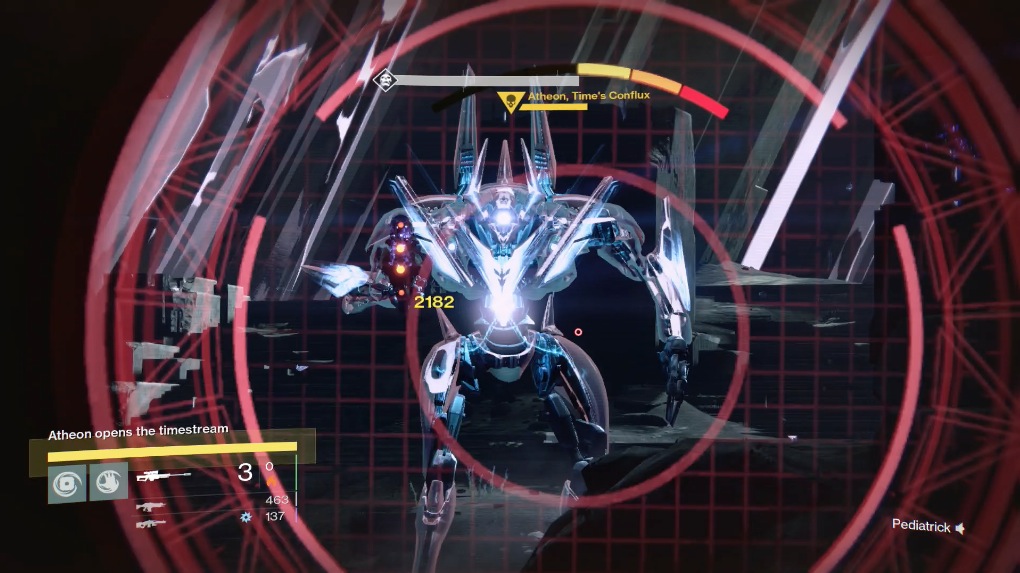
The final boss, Atheon, stomps into center stage and immediately begins firing at us with his huge gun. We scatter and begin to dodge and shoot at him, impressed with how our weapons seem to have basically zero effect on his massive health bar. This carries on for couple of seconds before he raises his hand in the air, and… suddenly I’m teleported to another place.
Chaos. What just happened? We’re all shouting into our mics. “I just got teleported!” “Where are we?” We begin trying to communicate, when we hear a telltale chime: Somewhere, there’s a oracle. If we don’t shoot it quickly, we’ll all die.
We’re all panicked, looking for the oracle, and my screen begins to go black. “I can’t see, I’m going blind!” I cry into my mic. No one is shooting the oracle. I can still hear it. My screen goes black. Shortly later, our entire team dies.
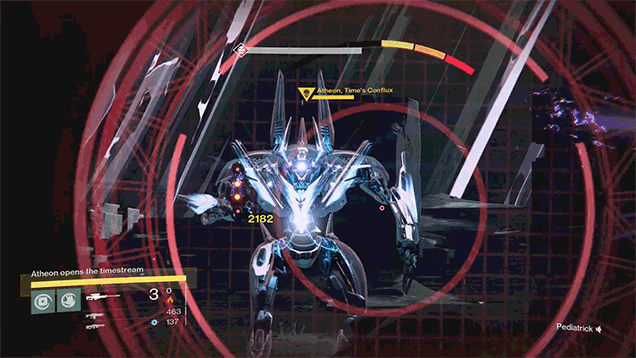
Reset. Atheon walks into the room and begins firing. We scatter and begin to shoot at him. As we do that, we’re already trying to pick apart what just happened. Some of us teleported, but others didn’t. Atheon raises his hand again, and I teleport once more. There’s a relic shield here, and I pick it up. I’m still going blind. I hear an oracle. My teammates spot one, just above our position where we were teleported. They begin shooting, but it’s too late — we hear another oracle, and another one. Soon we all die, and so does the rest of the team.
Reset. Atheon walks into the room and begins firing. We let this play out a couple more times, and begin to figure out what’s happening. About 30 seconds into the fight, Atheon is teleporting three of us directly into either the past or future-versions of this room. Once there, we must pick up the shield relic and fight our way back to the portal. The three people who remain in the room with Atheon must go and activate the portal so that we can safely return with the relic shield in hand.
There are wrinkles to this, of course. The teleported players begin a ritual of telling the remaining players where they have been sent, so that the three remaining players know which time portal to activate. “Mars” becomes code for the dusty future, while “Venus” is what we call the tropical past. Every time we teleport, we automatically, mechanically say “Mars” or “Venus.” (Well, except when we forget, and the rest of the team starts shouting “Where are you guys?” into their microphones.)
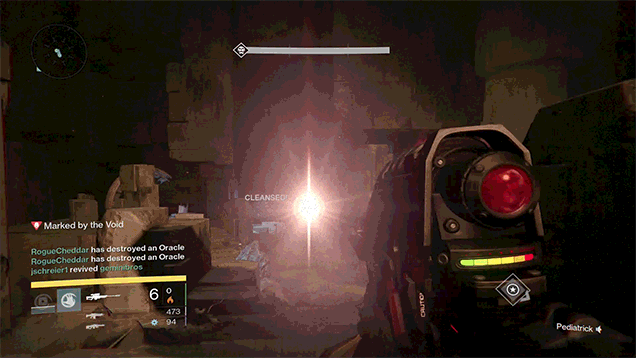
The twists continue: Everyone who is sent to the future or the past quickly starts going blind, so whoever is holding the shield is required to “cleanse” them periodically. Shortly after arriving in the future or the past, deadly oracles begin to materialise in the air above the other, no-less-deadly robots. One player must focus on the oracles while the other players focus on clearing a path through the robots to the gate. If one person dies or fails, it’s usually game over for all six.
Finally, a breakthrough! We determine that the three of us standing farthest away from Atheon are the ones who will be teleported. With this knowledge, we can assign three of us to act as a “home team” and the other three as an “away team,” and have set roles for each team. We quickly fall into our roles and become much more consistent at fighting our way back through the gates and, with the aid of the shield relic, finally begin doing some real damage to Atheon.
From there, it’s only a matter of time and technique-tweaking until we win. There are moments when it feels like we just won’t be able to do it, instances where we make a dozen perfect runs through the portals only to have a tiny error wipe the team out. Eventually (and, ok, with the help of a final strategy we found online) we figure out how to coordinate our attacks in order to do maximum damage while staying alive. We finally defeat Atheon.
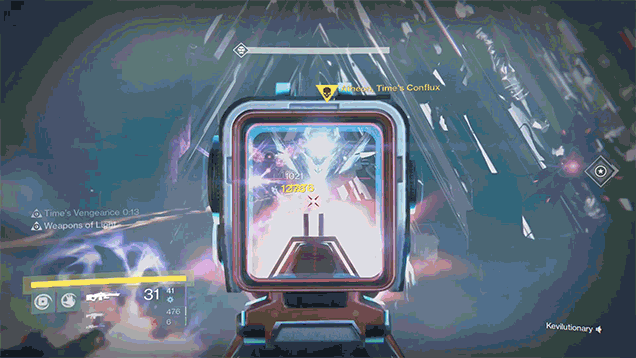
Our team celebrates, unified in our victory. It took us many hours — so many hours — to get here, but we did it. And despite all the other things we could’ve spent that time doing, our victory is rewarding precisely because it took so much teamwork. This wasn’t a matter of levelling up our weapons so that they do more damage, or increasing our armour rating so that our characters were tougher. This victory was about knowledge and strategy, about working together and carefully learning a problem and in the process, understanding how to solve it.
Playing through the Vault of Glass, it’s hard not to picture an alternate-dimension version of Destiny where the rest of the game is just as interesting. Unfortunately, we do not live in that dimension, and for all its appeal, the majority of Destiny is an Edge of Tomorrow-like exercise in grindy repetition.
When I asked Smith why that was the case, he said that due to the raid’s constrained structure, his team was able to make the game demand much more players.
“Look at the raid versus the structure of the rest of the game,” he said. “The raids are linear in a way that a given suite of missions [isn’t]. From encounter to encounter, in the raid, we’re able to build your knowledge base and teach you more in a very predictable way. And I feel like sometimes we can’t assure [that] organically in sort of a more linear campaign. We had this really good advantage of freedom, flexibility, and the knowledge of how you’re going to be able to constrain players.”
“I think it’s something that we’re definitely looking at across the entire breadth of the game going forward.”
I asked Smith if Bungie is considering spinning the kinds of challenges in the raid out to the rest of the game in future expansions. “I think that in a bunch of ways, the raid team is doing a lot of forward-looking development,” he said. “I think that we were given the freedom to explore, and that freedom manifested in a bunch of ways, whether it was the resources or time to test out different types of objectives and different types of experiences. Some of what you’re really describing when you talk about the thirteen or the fourteen bespoke mechanics come very simply down to different ways to fail. And that’s the thing that we were able to breathe into the action game in raids, and I think it’s something that we’re definitely looking at across the entire breadth of the game going forward.”
A bit later, he elaborated: “I think that people are craving different types of experiences. Giving people an opportunity to have different types of experiences in Destiny, of which I would say raiding encapsulates a number of different types of experiences, that’s an opportunity for us to grow moving forward.”
Sounds good to me. Wouldn’t it be cool if one of the bosses in a Destiny strike required the use of a relic shield, or if an area in a mission contained deadly gorgons that kill you on sight? Any single section of the Vault of Glass could be spun out into its own mission or boss battle. Here’s hoping Bungie follows through, and explores some new ideas, as well.
There are chests placed throughout the Vault of Glass, and opening each one gives you a chance to get some precious gear that can only be obtained by playing the raid. An exotic machine gun, or maybe a piece of powerful armour, that kind of thing. My favourite piece of loot that I’ve gotten so far has been this disco-ball armband, which makes my character look so freakin cool:
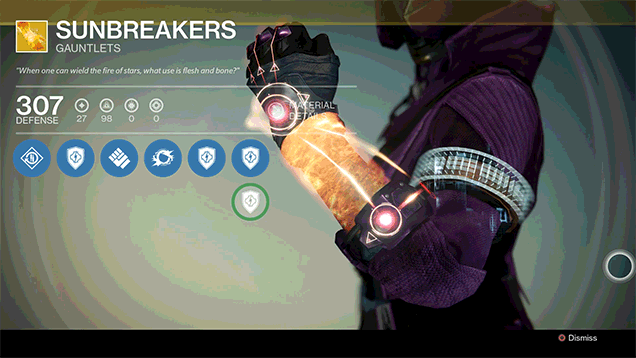
Every time our team would get to a chest, we’d all wait until everyone was present before opening it. As it turns out, that wasn’t necessary — every player will get loot from a chest even if they arrive way after it was opened — but even after we learned that was the case, we kept doing it. It feels good to stand together and celebrate our small victories, and I sense we’re not the only raid team with that tradition.
Smith confirmed that the chests don’t require the team to stand together to open them, but said that he likes to see teams engage in that sort of behaviour. “That anxiety that you’re describing,” he said, “like, ‘No no, let’s open it all together!’ That’s this awesome way that just feed into yet another moment that you got to have with your team.”
Those sorts of moments have certainly brought our team closer together. I played along with a few other journalists — my Kotaku colleague Jason Schreier, Lifehacker‘s Patrick Allan, Patrick’s friend Kevin, freelancer and sometime Kotaku weekend sub Mike Rougeau, and Digital Trends‘ Adam Rosenberg. Going in, I knew some of those guys better than others. Some, I’ve never met in real life. But after spending several nights banging our heads up against the Vault’s toughest challenges, I would follow each of them into virtual battle any day of the week.
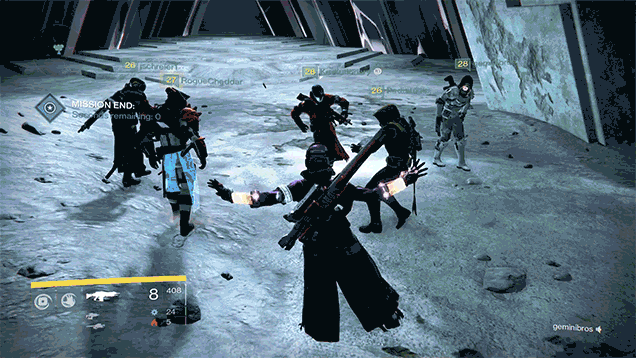
“One of the things that we’ve talked about a lot [at Bungie] is that one of the things that binds you together in that activity is the collective failure of your effort,” Smith said, laughing. “Your effort, forcing you to try again and again, update your strategy. It’s building camaraderie.
“I’ve talked a lot about how the raid is a lot like a ropes course,” he said. “It’s us teaching you how to be a group. If you look at how the activity is building groups and pulling people together, we hope that people play the raid together and end up meeting someone new and having a new friend, someone new to play with.”
As much as Smith’s talk of team-building and friendship sounds like touchy-feely PR-speak, it’s also accurate to my experience of the raid. The Vault of Glass has been the sort of challenging, rewarding team-challenge that the rest of Destiny promised, but generally didn’t quite manage to be. It has brought me closer together with people I barely knew, and has given me a feeling of genuine accomplishment that I haven’t gotten from a video game in ages.
We came, we saw, we blew up the giant robot. More please, Destiny.
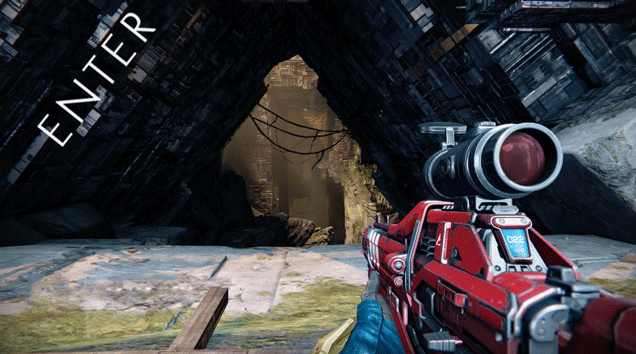
Comments
11 responses to “The Vault Of Glass Is The Best Thing In Destiny”
This is the thing, the first couple, maybe 3 times you run through the raid you’re looking around thinking how different it all is. Now with the weekly reset it’s slowly getting to the stage of ‘oh, I need to do the raid again to get the loot drops, no biggie, I’ll set aside an hour tonight to smash through it’. The VoG is exactly what Destiny needs, but this content needs to be coming in thick and fast while there’s not much else to do except the same story missions and strikes at high levels or play in the crucible
That said, this has done nothing to convince me that platform puzzles in a FPS are a good thing
I actually really like it. The disappearing platforms puzzle is still the cruellest boss in the Vault.
After playing this part with a couple of mates after a couple of drinks, I gotta says its probably the best part of the raid, pretty blood hilarious watching people slam into the cliff side.
I’ve got to remind myself to switch my Titan subclass right after the Templar fight, so that I have enough time for Fist of Havoc to charge up – then I can try to dive across.
My favourite part of the game was coming up with 101 ways to kill Master Rahool. F****** prick.
I’ve read enough articles like this to get me really excited about doing it, but I’m avoiding videos like the plague. I’ve spent a bit of time while I was on Venus Patrol near the first door watching a team trying to open it as It’s a reliable place to target Vex majors.
My main character is close to L25 now. Really hoping I get to have a crack at this with a bunch of virgins…
There are still plenty of us virgins running around. I’ve got a 27-28 Warlock (depending on which armor I use), a 27 Titan and a 26 Hunter. None of them have done the raid yet. Ive got 5 friends playing, but only one has done the raid so far. They still need decent weapons and more ascendant materials. So do I!
Cool. Hopefully in the next couple of weeks!
I have 3 x white shadders now completed it again last night.
Yeah its cool the first time you do it but then as you said the second time you finish it in about an hour depending on how competent your group is then its on constant farm and stops being fun and more of a why have i done it 6 times on 2 different hunters and still not gotten the chest piece so i can hit lvl 30….
By proper mmo raid standards it is SHORT, it is pathetically easy and the loot tables are terrible.
My group has started doing it on hardmode and the problem becomes clear destiny don’t know how to make difficult content without making it cheap and annoying. There is no healer there is no tank and its in first person so they are already limited but things like no revives don’t make it more skillfull they just make it so annoying, especially when they put things that basically 1 shot you.
Hell there is a a reason the entire first half of the raid is about standing back and cheeseballing it with snipers and that is because the mechanics of the entire game make it nearly impossible to do otherwise. The level “advantage” that bungie has done is just plain old terrible. Being lvl 29 instead of 30 should not reduce my damage by 30% nor my defence. Yet because of this once you have a group of 30’s the hardmode because a joke of its former self.
As much as I like playing Destiny and wish it was everything it was supposed to be, I feel by christmas this game will be nearly dead. They need about 2x as much content and it needs to be coming much faster. There should have been 3-4 raids the size of vault (progression raids too boot) but by the time the next one comes eveyr man and his dog who still cares will be 30 and so many levels above the min that they will also be a joke.